Welcome to the future of real estate in Indonesia. As we approach 2025, a wave of new property developments is set to redefine the urban and suburban landscapes across this diverse nation. From smart living townhouses to luxurious villas and eco-friendly apartment complexes, the upcoming projects promise to meet the evolving needs of modern residents and investors. Discover the latest property trends and find your next dream home or investment opportunity in this bustling market.
Property prices in Indonesia are expected to rise by 3% to 7% in 2025 from their 2024 values, providing an attractive prospect for both new home buyers and seasoned investors1. With a stable economy, an average GDP growth rate of 5% over the past few years2, and appealing property prices compared to other Asian nations, the real estate market here is booming. Key areas like Seminyak and Ubud in Bali are witnessing significant appreciation due to limited land availability and influx of international buyers1
Key Takeaways
- Property prices in Indonesia are expected to rise by 3% to 7% in 20251.
- Indonesia offers a stable economy with a 5% average GDP growth rate2.
- Popular real estate investment areas include Seminyak, Ubud, and Jakarta12.
- New developments include energy-efficient and eco-friendly buildings.
- Diverse opportunities for property development across nearly 18,000 islands2.
Introduction to Indonesia’s Property Market
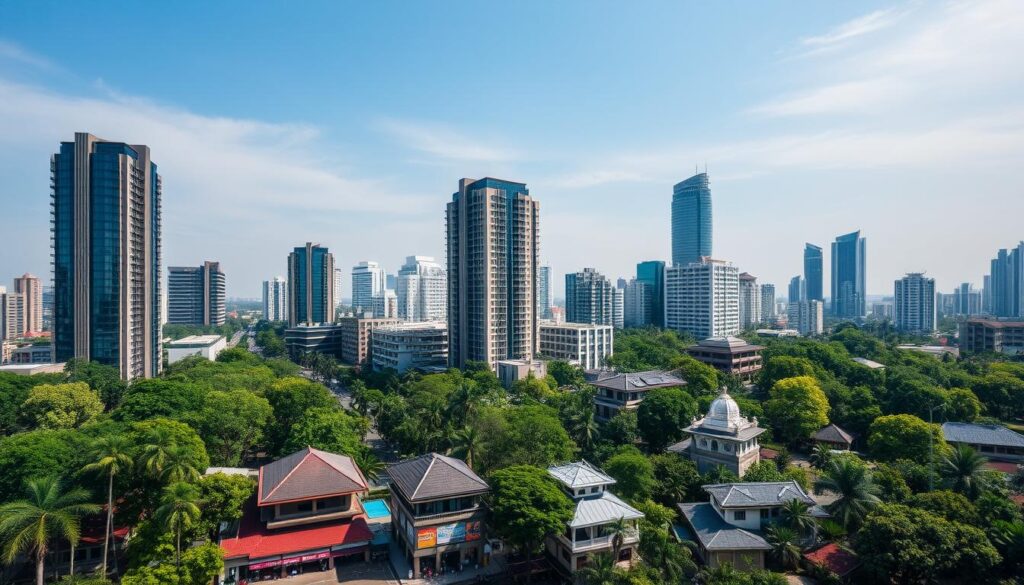
The Indonesia real estate sector has shown remarkable resilience over the years. A major driver behind this steady momentum is the nation’s economic stability and strategic initiatives by the government to promote infrastructure and housing projects. For instance, Indonesia’s GDP from real estate activities in 2022 amounted to IDR 488.31 trillion (USD 31 billion)3. This underlines the significant share and impact of this sector on the broader economy, making it an attractive destination for investment in Indonesia.
According to recent market estimates, the Indonesia real estate market is expected to reach USD 64.78 billion by 20243, with a Compound Annual Growth Rate (CAGR) of 5.82% from 2024 to 20293. Similarly, another study anticipates the market size to be USD 72.11 billion by 2024, with a CAGR of 7.95% for the same period4. This positive outlook is indicative of the property market growth trajectory and the increasing interest from both domestic and foreign investors.
Several factors contribute to the dynamic nature of Indonesia’s property market. The ‘One Million Houses’ (OMH) program, for instance, is a key governmental initiative aiming to construct at least one million housing units annually. By August 2023, approximately 634,132 housing units were recorded under this program3.
Other significant contributors to the market’s growth include the burgeoning demand for affordable housing projects, along with increased urbanization and per capita income, particularly among the young population4. Major players such as PT Intiland Development Tbk, Tokyu Land Indonesia, Agung Podomoro Land, Ciputra Group, and Sinar Mas Land have been pivotal in this trajectory, adopting innovative strategies to cater to the diverse needs of the market3.
The competitive landscape of Indonesia real estate is further driven by technological adoption, propelled by rising internet penetration and the expansion of e-commerce3. Moreover, foreign investment in Indonesia continues to grow, supported by specific regulatory frameworks such as minimum housing price requirements for foreigners varying by regions, which further ensure a structured property market.
An effective understanding of the Indonesia real estate sector also includes awareness of the tax landscape. For instance, the Land and Building Tax (PBB) rates typically range from 0.1% to 0.5% of the government-determined property value5. Besides, there are additional taxes like the rental income tax, varying based on residency status, and the Land and Building Transfer Duty, which is around 5% of the property value, paid by the buyer5.
In conclusion, the Indonesia real estate market presents a robust investment opportunity underlined by ongoing government initiatives, technological advancements, and an increasing demand for housing. Understanding these dynamics and market trends is crucial for leveraging the full potential of property market growth and making prudent investment decisions in Indonesia.
Key Trends in Property Developments Indonesia
Indonesia’s property sector is undergoing a transformative phase with emerging trends impacting market dynamics. This includes strides in sustainable construction methods, a significant tourism real estate impact, and the integration of innovative building technologies.
The Rise of Sustainable Construction Methods
The adoption of sustainable construction in Indonesia is gaining traction, featuring zero-carbon certified buildings and the use of eco-friendly materials. This shift not only responds to environmental concerns but also adds long-term value for property investors. Moreover, such practices directly contribute to Indonesia’s efforts to achieve a greener economy, providing sustainable solutions in urban planning.
Impact of Tourism on Real Estate
Tourism’s influence on Indonesia’s real estate market cannot be overstated. The surge in tourism has significantly boosted property developments, particularly in coastal areas. This influx amplifies the tourism real estate impact, fostering job creation and bolstering local economies. The demand for hotels, resorts, and serviced apartments has consequently increased, making tourism-related properties an attractive investment opportunity6. For instance, affordable housing projects integrated with tourist amenities are becoming popular7.
Technological Innovations in Building Design
Technological advancements are reshaping the architecture and construction landscape in Indonesia. From data analytics to virtual house tours, these innovations streamline operations and increase market transparency proptech trends6. Additionally, online property marketplaces and blockchain-enabled transactions are becoming more prevalent, enhancing efficiency in real estate transactions6. On the same note, technological integration promotes the development of smart homes and IoT-enabled office spaces, setting new standards in the industry.
Luxe Living: Luxury Villas in Bali
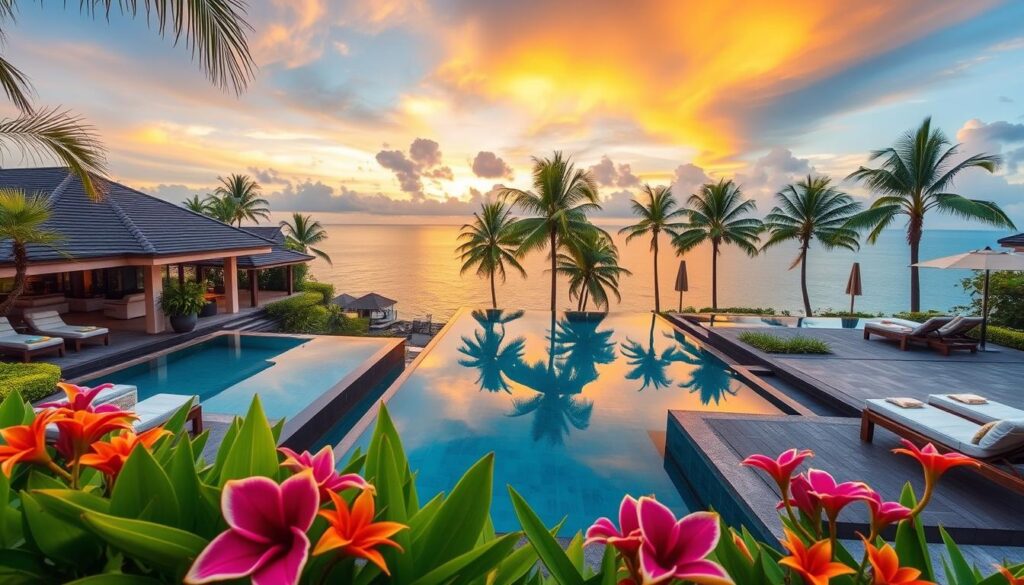
Bali remains a top destination for luxurious living with its range of high-end properties catering to international and local buyers. Known for its beautiful landscape and rich cultural heritage, Bali offers an exclusive experience in its luxury villas. With a predominant focus on modern elegance and traditional touches, these villas provide a perfect blend of opulence and comfort.
Vesna Townhouses in Badung, Bali
The Vesna Townhouses in Badung are a prime example of sophisticated living. These townhouses are renowned for their architectural elegance and modern amenities, making them an excellent choice for those seeking luxury villas in Bali. Each unit offers spacious living areas, infinity pools, and state-of-the-art facilities catering to various group sizes, accommodating anywhere from 2 to up to 10 guests8. The strategic location in Badung provides easy access to popular areas and windswept beaches, ensuring a comfortable and enjoyable stay.
Dharma Residence’s Unique Benefits
Dharma Residence stands out with its exclusive gated community, offering a safe and harmonious living environment. The residence provides a comprehensive array of facilities, such as private chefs, butler service, and wellness retreat facilities8. This makes Dharma Residence a preferred choice for discerning individuals seeking high-end living in Bali. Property investment here promises high rental yields, averaging around 15%, significantly higher than global averages9, further enhancing its appeal as a lucrative investment.
Aquamarine II’s Prime Location
Situated in Canggu, Aquamarine II villas boast an ideal location with easy access to lifestyle amenities such as beachfront cafes, luxury shopping outlets, and vibrant nightlife. Canggu’s consistent occupancy rates and premium rental prices during peak tourist seasons add to the attraction of these villas9. Offering panoramic ocean views and modern features, Aquamarine II villas are designed to provide an exclusive and high-end experience for guests8. With property prices in this area projected to rise by 5% to 10% by 2025, investing in Aquamarine II is a wise decision9.
| Property | Location | Price (IDR) | Special Features |
|---|---|---|---|
| Freehold luxury villa | Jimbaran | 13,500,000,000 | Sea view, private pool |
| Freehold bungalow | Pasut Tabanan | 14,000,000,000 | Riverside, spacious garden |
| 2-storey villa | Seminyak | 8,000,000,000 | Modern design, sea view |
| New villa | Canggu | 7,500,000,000 | Ocean view, mountain view |
Emerging Residential Properties in Jakarta
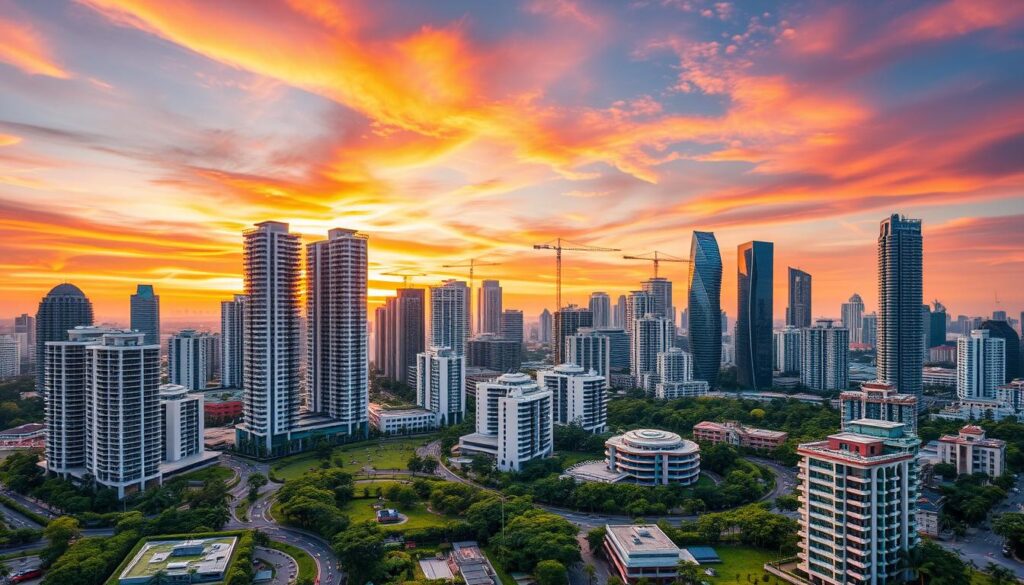
The Jakarta housing market is witnessing substantial growth, with diverse residential projects springing up across the city. The emergence of new residential properties in Jakarta is driven by the increasing preference for modern, sustainable living spaces. Currently, Jakarta boasts a total of 226,815 apartment units, reflecting a slight quarterly increase of 0.37% and an annual rise of 1.34%10. The market is anticipated to welcome an additional 9,317 units by 2026, distributed as follows: 4,516 units in 2024, 3,956 in 2025, and 845 units in 202610.
One of the standout projects in Jakarta’s Central Business District (CBD) is the Two Sudirman venture, which encompasses 355 units and epitomizes the Transit-Oriented Development (TOD) concept10. This approach emphasizes accessibility and convenience, making it an appealing choice for the city’s expatriates and High Net-Worth Individuals (HNWI). Similarly, developments such as Pluit Sea View and Cleon Park in non-CBD areas have enriched Jakarta’s apartment supply by adding 838 units10.
Another significant factor boosting the Jakarta housing market is ongoing infrastructure advancements, particularly the MRT phase 2A. This development is attracting attention for new projects near stations like Thamrin, Monas, and Harmoni10. The implementation of these TOD principles is reshaping the landscape, with new modern homes Jakarta designed to cater to a diverse array of demographics, from young professionals to growing families.
Underpinning Jakarta’s real estate surge is Indonesia’s broader economic forecast. The Indonesian real estate market is projected to reach USD 64.78 billion in 2024 and expand to USD 85.97 billion by 2029, growing at a Compound Annual Growth Rate (CAGR) of 5.82%11. This optimistic outlook is bolstered by government policies fostering a robust housing market and the One Million Houses program, which had recorded approximately 312,290 housing units by May 202111. Additionally, Jakarta’s serviced apartments observed a 3.5% rise in occupancy rates, reaching 60.5% in Q3 202311.
The demand for residential properties in Jakarta is further driven by the introduction of innovative modern dwelling projects, such as the Wisteria project in East Jakarta. This development includes 381 garden-concept landed homes, with amenities designed for young couples, families, and property upgraders12. The starting price for these units is Rp 1.5 billion, offering residents modern security systems and community facilities like gyms and swimming pools12.
Commercial Real Estate Investments Across Indonesia
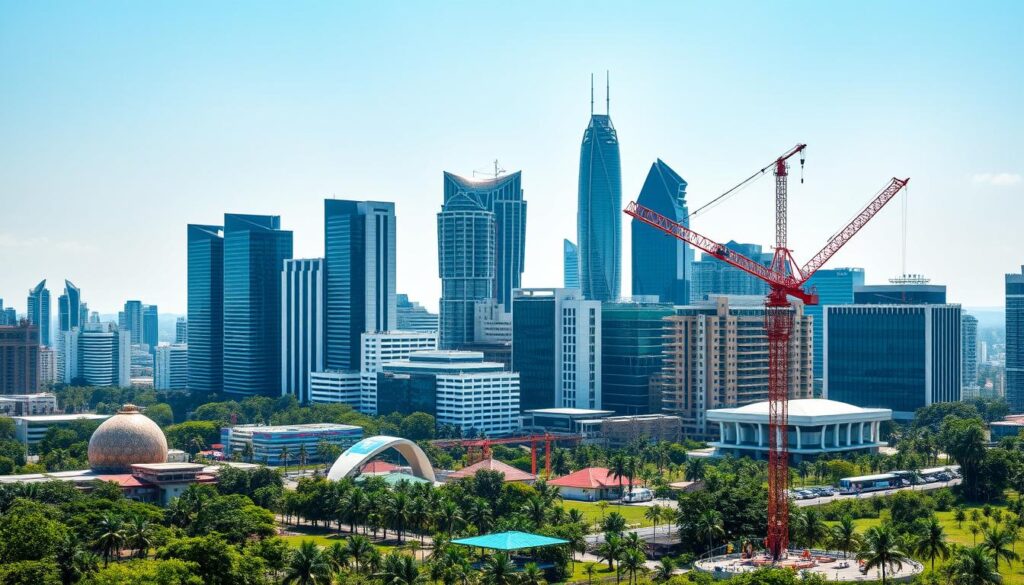
Indonesia’s commercial real estate market is rapidly evolving, presenting lucrative opportunities for investors. With the market size estimated at USD 21.04 billion in 2024 and projected to grow at a CAGR of 7.40% from 2024 to 2029, reaching USD 30.07 billion, the potential is significant13. Government initiatives and infrastructure development are crucial drivers of this growth, with a substantial allocation of IDR 2.7 quadrillion (USD 190.1 billion) in 202213.
Key Areas for Investment
The diverse landscape of Indonesia commercial properties offers various key areas for investment. Regions such as Java, Sumatra, Kalimantan, and Sulawesi are identified as prime locations due to robust real estate market trends14. The average land prices are rising, with Jakarta leading in prices, making it a focal point for commercial real estate investments13.
- Jakarta Central Business District (CBD): Experienced its first positive net-take-up of 17,900 sqm in Q4 2021 after multiple quarters of contraction13.
- Bali: A hotspot for tourism-driven developments, witnessing high occupancy rates and robust rental markets15.
- Surabaya and Medan: Emerging as dynamic markets with favorable growth conditions for commercial investments15.
Future Prospects
Looking ahead, the commercial real estate market in Indonesia is poised for continued growth. The adoption of technology, the rise of co-working spaces, and a strong emphasis on sustainable building practices will drive future market trends14. Real estate market trends indicate that the sector will benefit from government support through simplified regulations and enhanced infrastructure, attracting both local and foreign investments15.
Furthermore, the market is segmented into various types such as offices, retail, industrial, logistics, multi-family, and hospitality, catering to a wide range of investor interests14. With key players like Agung Podomoro Land and Ciputra Group actively shaping the landscape, Indonesia commercial properties are set to experience significant growth14.
| Region | Key Investment Drivers | Growth Prospects |
|---|---|---|
| Jakarta | High land prices, infrastructure development | Positive net-take-up, rising demand |
| Bali | Tourism, high rental yields | Strong rental market, high occupancy rates |
| Sumatra | Government initiatives, emerging markets | Diverse investment options, steady growth |
Resort Developments in Lombok
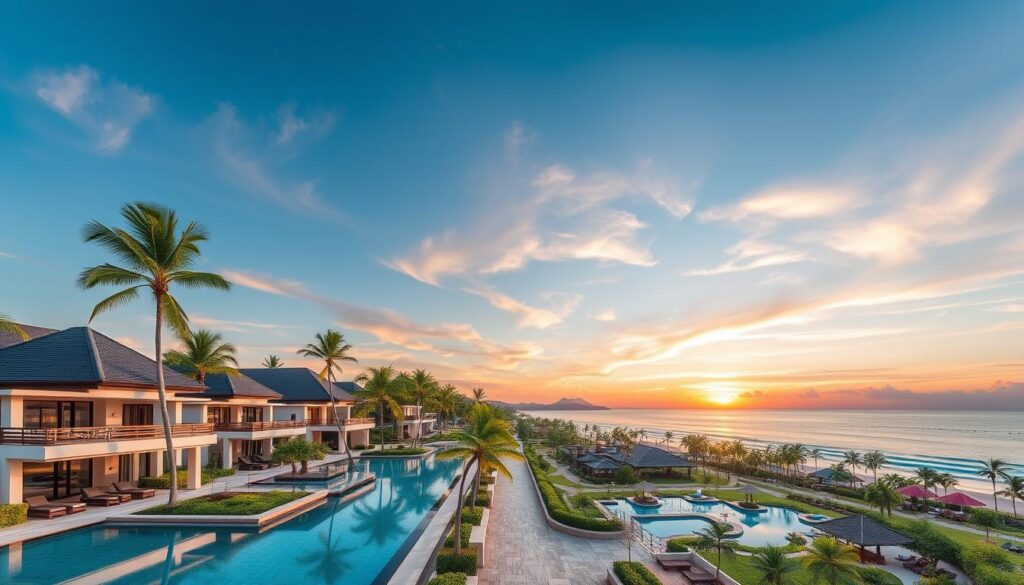
Resort developments Lombok are buzzing with exciting new projects designed to attract international tourists and investors alike. As Lombok tourism real estate grows steadily, several noteworthy projects have emerged, offering luxurious accommodations and significant investment opportunities Lombok.
Popular Resort Projects
The opening of The Sira, a Luxury Collection Resort & Spa, Lombok, in November 2024 marks Marriott International’s first luxury property on the island. This resort will feature 60 luxurious suites with ocean views, private pool villas, Presidential Suites, and Beach House accommodations16. The Sira is also equipped with a 230-foot outdoor pool and a vitality pool, an outdoor treatment room, yoga sessions, and a 24-hour fitness center16.
Among the other prominent projects, Tampah Hills stands out with its sustainable bespoke design villas. Spanning over 120 hectares, this luxurious resort offers a sports center, massive park areas, and a community garden17. The villas range from 2 to 5 bedrooms, with nightly rates starting at IDR 10,000,000 to IDR 22,000,000, translating approximately to $620 to $1390 USD17. Guests can enjoy world-class amenities, including a private chef, tasting menu dinners, and available 24-hour butler service17.
Investment Opportunities
Lombok is positioning itself as a fast-growing destination attracting worldly travelers looking for an off-the-beaten-path alternative to more popular spots like Bali and Thailand16. The region saw over 2 million visitors in 2023, representing a 20% increase from the previous year16, which underscores the robust growth potential of Lombok tourism real estate.
The government’s designation of Lombok as a priority tourism zone has further sparked new developments on the island, including Pullman Lombok Merujani Mandalika Beach Resort and Innit Lombok16. With such initiatives, investing in Lombok offers promising returns, especially in resort developments Lombok, poised to cater to the increasing tourist influx and high demand for upscale accommodation.
Invest Islands is a noteworthy entity driving these high-end projects. They have introduced Gran Melia Lombok Resort & Spa, a luxury resort development featuring 125 private villas tailored for holiday homeowners and investors16. The pricing for these villas ranges from $681,000 to $1.4 million, each showcasing unique designs and amenities like a beach club, spa, and restaurants16.
The combination of well-planned resort developments coupled with the growing popularity of Lombok tourism real estate presents attractive investment opportunities Lombok for savvy investors. The blend of luxury, sustainable living, and leisure facilities ensures that Lombok remains on the radar of both vacationers and real estate investors.
Land Acquisitions in Sumatra
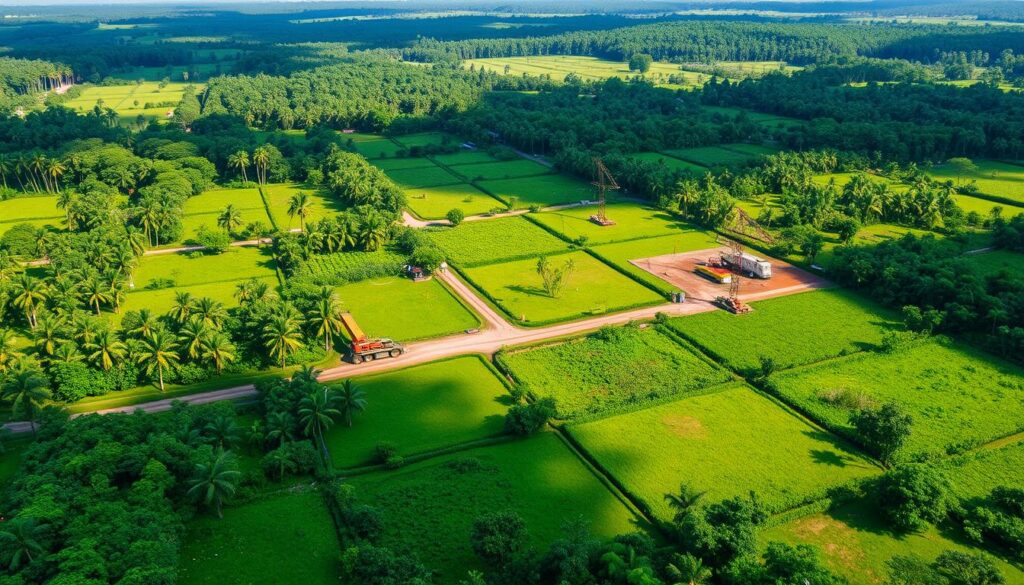
Investing in Sumatra land has become increasingly attractive due to the region’s significant growth potential and resource-rich areas. One major factor driving interest in Sumatra real estate is the region’s vast land parcels, offering ample opportunities for diverse investment projects. Furthermore, despite the complexities in Indonesia’s land governance, such as insecure land transactions influenced by overlapping regulations, the strategic benefits of land acquisitions in Sumatra outweigh these challenges1819.
Sumatra’s appeal to investors also extends to its resource-rich areas, particularly in terms of forestry and mining sectors. Indonesia’s leadership in the global mining sector, albeit marked by policy and regulatory uncertainties, provides lucrative prospects for those willing to invest in Sumatra land18. Additionally, unresolved issues surrounding disappearing forests and rural landlessness highlight the need for responsible investment to ensure sustainable development and benefit local communities19.
With the rise of global agendas on sustainability and corporate social responsibility, land acquisitions in Sumatra offer potential investors the chance to contribute positively while securing financially attractive ventures. The availability of large land parcels further bolsters the case for investment in Sumatra real estate, positioning the region as a strategic focal point for both growth and resource management19.
Given these factors, Sumatra stands out as a prime location for real estate investments, drawing attention from local and international investors alike. By navigating the region’s regulatory landscape and leveraging its abundant resources, stakeholders can ensure mutually beneficial outcomes that support both development goals and community needs.
Sustainable Construction Methods in 2025 Projects
In 2025, sustainable construction methods will be a dominant trend in property developments across Indonesia. The focus on building zero-carbon buildings and utilizing eco-friendly construction materials ensures minimal environmental impact and promotes operational efficiency in the long run. With increasing support from both private and public sectors, Indonesia is making significant strides in introducing sustainable infrastructure initiatives.
Zero-Carbon Certified Buildings
The concept of zero-carbon buildings is gaining traction globally, and Indonesia is no exception. These buildings are designed to produce zero net carbon emissions throughout their lifecycle, from construction to operation. Sustainable operations offer better operational efficiency and long-term cost savings, despite potentially higher initial construction costs compared to traditional projects20. Additionally, optimizing air conditioning temperatures by just 1°C can save up to 10% of the energy used for cooling or heating the building, highlighting the importance of energy conservation in zero-carbon projects20.
Eco-Friendly Materials and Techniques
Eco-friendly construction involves using materials and techniques that reduce environmental impact. Water optimization solutions, for instance, have helped office projects save 17% of water consumption per square meter of usable area, with residential projects also achieving a 3% reduction20. Furthermore, adjusting air conditioning can have a notable impact on energy usage, contributing to the sustainable projects’ goals. In recent years, Indonesia has seen a notable increase in green projects, showcasing the country’s commitment to environmental sustainability20.
Both private and public enterprises in Indonesia are contributing significantly to sustainable infrastructure development21. The country is also incorporating Responsible Business Conduct (RBC) principles into laws and practices, addressing areas such as human rights, labor rights, and environmental protection21. The adoption of these eco-friendly construction methods and principles plays a crucial role in paving the way for a greener future in Indonesia’s property market.
Prominent Property Investment Opportunities in 2025
Indonesia is teeming with property investment opportunities as we approach 2025. Labuan Bajo stands out as a key destination, highlighted as one of the National Tourism Strategic areas or Super Priority Tourism Destinations22. This region has witnessed a significant increase in land prices near tourist destinations, making it a lucrative choice for both domestic and international investors22.
Bali continues to attract attention, particularly in the Bukit Peninsula and Uluwatu regions, where ongoing developments and the rising demand for high-end accommodations are drawing investors. Bali’s natural beauty, combined with the lack of international-standard facilities have created a ripe environment for property investment opportunities22. Investors can look into diverse options like villas, hotels, and luxury residences, considering the high returns and long-term value. For more details on Bali’s investment potential, interested readers can explore additional developments by the Mirah Developments.
The Banyan Group, which has developed over 80 properties in 22 countries, is another key player in property investment trends23. As the Most Awarded Developer for Asia/Pacific at the International Property Awards 2024 – 2025, the Banyan Group plans to double its portfolio in the next decade, highlighting over 60 spas and multiple retail galleries and golf courses23. This ambitious expansion highlights significant property investment opportunities in regions like Phuket, where Laguna Residences provide world-class amenities23.
Global trends also indicate that the alternative investment sector has grown tremendously, from $7.49 trillion in 2015 to $15.28 trillion in 2024, with a compound annual growth rate (CAGR) of 9.3%24. This sector encompasses equity and debt investments in real estate, which reached $1.3 trillion in Assets Under Management (AUM) in 2023 and is expected to grow to $1.9 trillion by 202724. Sustainable investments, now representing 36% of total AUM, are progressively shaping the real estate market and offering new avenues for investors24.
In summary, Indonesia offers a multitude of property investment opportunities in 2025 with regions like Labuan Bajo and Bali leading the way. Additionally, global real estate investment trends and the Banyan Group’s extensive development activities further enhance the attractiveness of investing in the Indonesian market. As these trends continue to evolve, investors can expect substantial returns and long-term value from Indonesia investment properties.
Tourism-Driven Developments in Coastal Areas
Tourism-driven developments in Indonesia’s coastal area properties have significantly impacted community dynamics and local economies. These developments not only attract tourists but also bring economic upliftment and infrastructural improvement to coastal regions.
Impact on Local Communities
The rapid coastal erosion in Bali has highlighted the need for integrated coastal management to balance tourism-driven developments with environmental protection. Such developments, while boosting tourism, also have profound community impacts in Indonesia, from altering daily life to affecting traditional livelihoods25.
Efforts in coastal management, such as those implemented in Olele Marine Park, blend community engagement with strategic resource preservation. Incorporating principles like the Rio Declaration on Environment and Development can ensure sustainable tourism practices that support marine biodiversity and address community needs26.
Economic Benefits
Tourism-driven developments in coastal areas generate substantial economic benefits, creating job opportunities and fostering infrastructural enhancements. Coastal tourism stands as a significant economic component in Indonesia, contributing to both local and national economies25.
Marine parks, known for their exceptional underwater biodiversity, offer untapped potential for tourism. The Regional Tourist Development Master Plan for Bone Bolango Regency prioritizes preserving natural resources while promoting geotourism. This strategy not only safeguards the environment but also ensures economic prosperity for local communities through sustainable tourism practices26.
| Region | Development Approach | Economic Impact |
|---|---|---|
| Bali | Integrated Coastal Management | High due to tourism revenues and job creation25 |
| Olele Marine Park | Geotourism & Sustainable Practices | Moderate, focusing on long-term sustainability and community benefits26 |
Incorporating Local Architectural Styles
In modern Indonesian property developments, there’s a growing trend to incorporate local architectural styles that honor the nation’s rich cultural heritage. This fusion of traditional Indonesian architecture with contemporary design elements not only preserves cultural heritage buildings but also meets the practical needs of today’s occupants.
Traditional Indonesian architecture is characterized by the use of natural materials such as bamboo and wood in housing designs, reflecting a deep connection to the environment27. Sustainable building practices are becoming more mainstream, with developers increasingly using eco-friendly materials such as reclaimed wood27. These efforts are crucial in ensuring compliance with environmental regulations and protecting natural resources.
- Use of Natural Materials: Traditional Indonesian homes commonly feature timber and bamboo, which are naturally sourced and renewable, contributing to eco-friendly construction28.
- Elevation and Climate Adaptation: Traditional homes are built on stilts to enhance airflow, manage water runoff, and protect against pests, adapting seamlessly to Indonesia’s humid and monsoon climates28.
- Distinct Regional Styles: From the Rumah Gadang of West Sumatra to the high-walled garden compounds of Balinese homes, various regions showcase unique architectural motifs and construction techniques28.
Community engagement in housing projects through cultural principles such as gotong royong—an inclusive planning process involving local communities—ensures that new developments align with the specific needs and values of residents27. This synergy between cultural heritage and modern functionality not only adds aesthetic value but also fosters a sense of belonging and identity within communities.
Moreover, traditional Indonesian architecture is heavily influenced by various external cultures, including India, China, Arab, and Europe28. These influences have contributed to the development of the country’s unique architectural identity. For instance, Hindu-Buddhist architecture is epitomized by grand religious structures like the Prambanan complex and the Borobudur monument, showcasing the depth and sophistication of Indonesia’s historical architectural endeavors28.
Despite the decline of traditional rumah adat due to factors such as colonial perceptions and market economy dynamics, there is a concerted effort to revive these architectural forms within modern developments28. As developers strive to balance tradition and innovation, the incorporation of local architectural styles becomes a testament to Indonesia’s commitment to preserving its cultural heritage buildings while addressing present-day demands.
| Feature | Traditional Indonesian Homes | Modern Developments |
|---|---|---|
| Construction Materials | Bamboo, Wood | Reclaimed Wood, Sustainable Options |
| Design Elements | Stilt Elevation, Natural Ventilation | Eco-Friendly, Energy-Efficient |
| Cultural Integration | Distinct Regional Styles | Inclusive Community Planning |
| Sustainability | Traditional Practices | Modern Environment Compliance |
By seamlessly integrating these timeless elements into new constructions, Indonesia’s property developments are not only ensuring longevity and adaptability but also celebrating the nation’s rich cultural tapestry.
Conclusion
As we close this comprehensive overview of the property market in Indonesia, it’s clear that the industry is undergoing significant transformations. The drive towards sustainable property developments, the integration of technology in building design, and the preservation of local architectural styles are proving to be crucial in shaping the future of Indonesian real estate. The Indonesia property outlook appears positive, with key trends pointing towards a more sustainable and technologically advanced market.
The interaction between various sectors—residential, commercial, and tourism-driven properties—signals a dynamic future for property investments. The data shows that the number of Health Cards (KIS) recipients in Indonesia was 171.9 million people, representing 66.4 percent of the population, in 201629. Moreover, the country’s emphasis on road infrastructure, which returned to pre-financial crisis levels by 2010, with road vehicles accounting for 70 percent of total freight ton-km, ensures better connectivity and accessibility for property developments30.
Despite challenges like poverty rates—still significant at 22.76 million people—and the quality of infrastructure indices related to roads, the future of Indonesian real estate remains promising2930. Investment strategies focusing on cultural preservation and the development of clinically effective and technologically integrated structures will undoubtedly continue to propel the industry forward. By leveraging media monitoring and understanding consumer preferences, property groups can make informed decisions that align with evolving demands more effectively31.
In summary, the Indonesia property outlook is bright, with a strong emphasis on sustainable property developments, technological advancements, and cultural preservation playing pivotal roles. Stakeholders must continue to adapt and innovate to maintain this positive trajectory and capitalize on emerging opportunities.
FAQ
What are the new property developments in Indonesia scheduled for completion in 2025?
The upcoming wave of property developments in Indonesia includes a mix of residential and commercial real estate projects such as luxury villas in Bali, sustainable residential properties in Jakarta, and resort developments in Lombok. These developments focus on incorporating new, sustainable construction methods and technological innovations to redefine urban landscapes.
What factors are driving the growth of Indonesia’s property market?
Indonesia’s property market growth is fueled by economic stability, increased foreign investment, and governmental initiatives promoting infrastructure and housing projects. Additionally, the market’s resilience has been a significant contributor to its continuous development.
How is sustainable construction being implemented in Indonesia’s upcoming real estate projects?
Sustainable construction methods in Indonesia’s 2025 projects include the use of zero-carbon certified buildings and eco-friendly materials. These practices aim to reduce the environmental impact and promote eco-conscious building techniques.
What impact does tourism have on real estate developments in Indonesia?
Tourism significantly influences real estate developments, especially in coastal areas like Bali and Lombok. These developments boost local economies by creating employment opportunities and improving infrastructure, attracting further investment in the tourism and hospitality sectors.
What technological innovations are being seen in Indonesia’s property sector?
Technological innovations in the Indonesian property sector include advanced architectural design and construction technologies that streamline operations and enhance efficiency. These innovations set new industry standards and contribute to more sustainable and modern living spaces.
What are some examples of luxury living options available in Bali?
Premier luxury living options in Bali include Vesna Townhouses in Badung, which boast modern amenities and architectural elegance, Dharma Residence’s exclusive gated community with comprehensive facilities, and Aquamarine II’s strategic location in Canggu with easy access to lifestyle amenities.
What are the key areas of development for residential properties in Jakarta?
Key development areas for residential properties in Jakarta focus on modern, sustainable living spaces. These developments aim to cater to the evolving demands of the city’s diverse demographics, offering housing that aligns with the needs of a bustling urban environment.
Which areas are ripe for commercial real estate investment in Indonesia?
Commercial real estate investments in Indonesia are particularly promising in major urban centers and growing economic hubs. Future prospects indicate strong market drivers, and strategic planning opportunities for investors looking to capitalize on Indonesia’s commercial property market trends.
What are some popular resort projects in Lombok?
Lombok is home to several popular resort projects that attract tourists and investors alike. These include luxury beachfront resorts and eco-friendly retreat centers, contributing to the island’s booming tourism-driven real estate sector.
Why are land acquisitions in Sumatra appealing to investors?
Land acquisitions in Sumatra are attractive due to the region’s growth potential, availability of large land parcels, and strategic benefits linked to resource-rich areas. These factors make Sumatra an ideal location for long-term real estate investments.
What are the benefits of zero-carbon certified buildings?
Zero-carbon certified buildings significantly reduce the environmental impact by minimizing carbon emissions during construction and throughout the building’s lifecycle. These buildings contribute to sustainability goals and offer long-term operational cost savings.
Where are the prominent property investment opportunities in Indonesia for 2025?
Prominent property investment opportunities in 2025 span across various regions in Indonesia, including luxury villas in Bali, residential properties in Jakarta, and resort developments in Lombok. Investors are encouraged to seek areas with high potential for growth and returns.
How do tourism-driven developments benefit local communities in Indonesia?
Tourism-driven developments enhance local communities by creating employment opportunities, stimulating economic growth, and improving infrastructure. These developments also bring increased visibility and investment to the regions, fostering overall community development.
How are modern property developments in Indonesia incorporating traditional local architectural styles?
Modern property developments in Indonesia are embracing traditional local architectural styles to preserve cultural heritage while addressing contemporary needs. This integration enhances the aesthetic appeal, adds cultural significance, and promotes sustainable design principles reflective of local traditions.
Source Links
- https://bambooroutes.com/blogs/news/indonesia-price-forecasts
- https://indonesia-real.estate/
- https://www.mordorintelligence.com/industry-reports/real-estate-market-in-indonesia
- https://www.mordorintelligence.com/industry-reports/residential-real-estate-market-in-indonesia
- https://baliexception.com/info/a-guide-to-real-estate-investment-in-indonesia/
- https://www.socialexpat.net/jakarta-property-market-trends-2024-indonesia-residential-property-and-more/
- https://www.imarcgroup.com/indonesia-residential-real-estate-market
- https://www.thetimes.com/travel/destinations/asia-travel/indonesia/bali/best-villas-in-bali-pw8jr38z8
- https://seratnest.com/housing-and-structures/houses-for-sale-in-bali/
- https://realestateasia.com/residential/news/jakarta-see-over-9300-new-apartments-2026
- https://www.cekindo.com/blog/indonesian-real-estate
- https://www.keppel.com/realestate/id/en/Inspiration/Keppel-Land-And-Metland-Launch-New-Landed-Housing-Development-In-East-Jakarta
- https://www.mordorintelligence.com/industry-reports/commercial-real-estate-market-in-indonesia
- https://www.imarcgroup.com/indonesia-commercial-real-estate-market
- https://spacecoastdaily.com/2024/11/unlocking-opportunities-investing-in-indonesias-booming-real-estate-market-through-investment-properties/
- https://www.forbes.com/sites/rogersands/2024/10/01/lombok-indonesia-to-welcome-luxurious-resort-and-spa/
- https://www.tampahhills.com/
- https://www.land-links.org/country-profile/indonesia/
- https://bookshop.iseas.edu.sg/publication/2155
- https://www.savills.co.id/blog/article/219307/vietnam-eng/sustainable-real-estate–from-green-building-design-to-efficient-operations.aspx
- https://www.oecd.org/content/dam/oecd/en/publications/reports/2024/10/responsible-business-conduct-for-sustainable-infrastructure-in-indonesia_0a84d0a9/979472ba-en.pdf
- https://366property.com/2024/10/17/promising-property-investment-in-labuan-bajo/
- https://centrickinvest.com/investment-properties/banyan-tree-property-investment/
- https://medium.com/@MKthoughts/unlocking-indonesias-alternative-investment-potential-mapping-the-path-to-market-maturity-faad9b4c35c2
- https://www.responsibletravel.org/wp-content/uploads/sites/213/2021/03/costal-marine-tourism-trends-coral-triangle.pdf
- https://www.mdpi.com/2071-1050/16/3/1272
- https://seratnest.com/housing-and-structures/traditional-and-modern-indonesian-housing/indonesian-housing/
- https://en.wikipedia.org/wiki/Architecture_of_Indonesia
- https://sustainabledevelopment.un.org/memberstates/indonesia
- https://documents1.worldbank.org/curated/zh/366991468269399430/pdf/733030WP0Indon00disclosed0100180120.pdf
- https://www.heritage.org/index/pages/country-pages/indonesia

